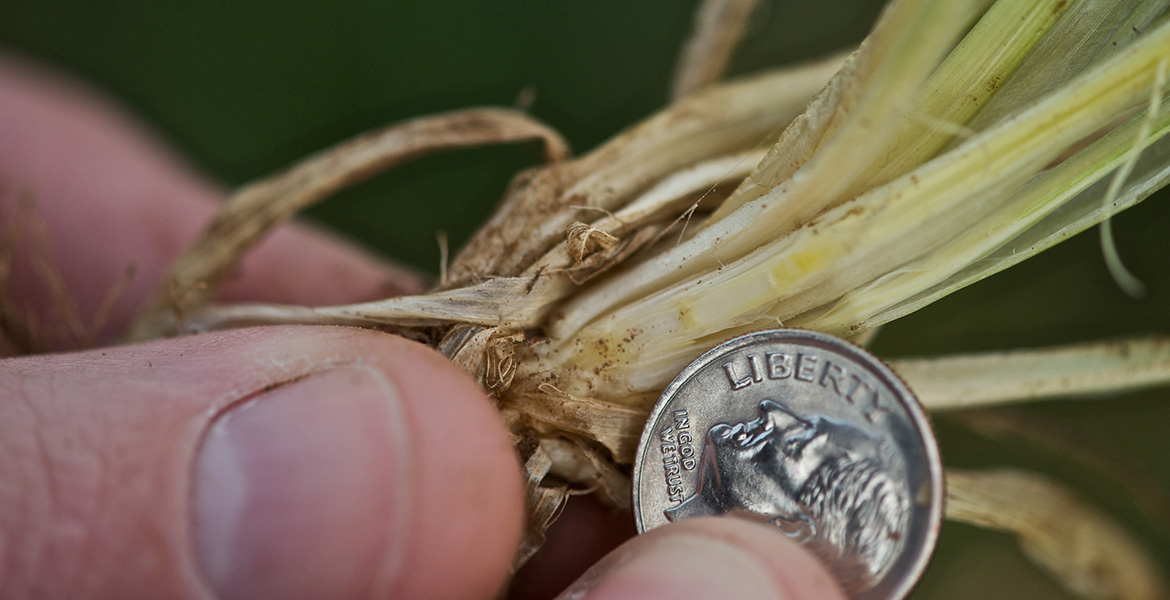
Producers of dual-purpose wheat should check for first hollow stem stage
Tuesday, February 9, 2021
Agricultural producers who plant winter wheat as part of a dual-purpose graze-and-grain management system need to ensure cattle are not grazing past first hollow stem stage of the crop, according to Oklahoma State University Division of Agricultural Sciences and Natural Resources recommendations.
Dual-purpose graze-and-grain operations account for about half of the wheat acreage in Oklahoma and a significant portion of wheat grown in northern Texas and southern Kansas.
Although grazing prior to first hollow stem, often referred to as FHS, typically has a limited effect on wheat yields later in the growing season, extended grazing beyond that stage can greatly reduce yields, said Amanda de Oliveira Silva, OSU Extension small grains specialist.
“Yield loss from grazing past first hollow stem can be as much as 1% to 5% per day,” she said. “It comes down to the amount of green leaf tissue left and the weather conditions after grazing. Cool, moist conditions after cattle removal allow for more time for the plants to recover.”
FHS occurs when wheat stems begin to elongate and the stem above the roots and below the developing head becomes hollow. Typically, this occurs when the hollow stem portion of the plant is 5/8 inch long. The occurrence of first hollow stem depends on the wheat variety and on climatic factors such as temperature and precipitation.
To check for FHS, go to a non-grazed area of the pasture and pull four to five plants. Plants must be dug up because much of the hollow stem present will be below the soil surface. Hollow stem must be measured from a non-grazed area in the same wheat field because the act of grazing delays stem elongation and therefore when first hollow stem occurs.
Good places to find suitable plants are the corners of a pasture or non-grazed areas just outside the fence line, Silva said. Select the largest tillers on the plants. Split the stems open lengthwise starting at the base. A sharp razor or box cutter will make the job easier.
“If there is 5/8 inch of hollow stem below the developing wheat head, it’s time to pull cattle off the wheat pasture,” Silva said. “If you don’t have a ruler, a dime is a good measuring device for first hollow stem as the coin is about 5/8-inch diameter.”
Wheat sown early will tend to reach FHS before late-sown wheat. Moderate wintertime conditions such as what Oklahoma has experience in the past few months and adequate rainfall also will promote earlier onset of FHS.
A smartphone app, the Mesonet First Hollow Stem Advisor, may prove useful to producers. The app uses 4-inch Soil Temp Under Vegetative Cover to estimate probabilities for the date when FHS is expected to occur. The app is available through the Mesonet website, under the “Crop/Wheat” and “Livestock/Cattle” tabs of the Agriculture section. Producers can select their wheat variety and then use maps, charts or graphs to check probability of first hollow stem occurrence.
“This online tool is a great way to better know when it is time to start scouting instead of using a specific calendar date or just going by the weather,” Silva said. “The most accurate method of determining first hollow stem stage is still checking your wheat fields often.”
For most expected weather and price conditions, extending grazing beyond FHS for wheat intended for grain harvest is not likely to generate more net income than terminating grazing at FHS.
“We can’t stress enough that wheat growers with dual-purpose operations need to be mindful of weather conditions, which can change from false spring to winter blasts quickly in Oklahoma and potentially affect the rate of first hollow stem stage emergence,” said Mike Schulte, Oklahoma Wheat Commission executive director. “Be vigilant. Scout the fields regularly.”
Fact sheets detailing research-based information about first hollow stem stage and dual-purpose graze-and-grain management practices are available online and through OSU Extension county offices.
Another useful online resource for dual-purpose wheat growers is research by J. Dillon Butchee and Jeff Edwards, originally published in 2013. The study indicated that wheat growers can use the percentage of green canopy cover to monitor wheat pastures from the end of fall growth to grazing termination in February or early March and make in-season adjustments to stocking density to prevent overgrazing.
MEDIA CONTACT: Donald Stotts | Agricultural Communications Services | 405-744-4079 | donald.stotts@okstate.edu
